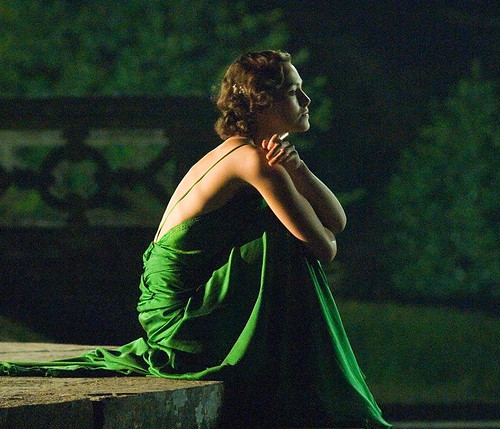Films can succeed a million different ways, but when they do, each is entirely different from one another. The three best films I’ve seen all year – John Carney’s Irish alt-folk musical Once, Sean Penn’s riveting character portrait, Into the Wild, and Doug Block’s family documentary with a twist, 51 Birch Street – are alike only in the completeness of their directors’ vision. It’s not that there aren’t influences (Hard Day’s Night, for example, on Once), but that’s really all they ever seem to be. Films that don’t completely succeed, however, often feel like anthologies of homages to other, better films. Atonement, Joe Wright’s adaptation of the Ian McEwan novel, falls into this latter category. It’s not a bad film, but it doesn’t completely gel – there are moments when I felt I was watching a remake of The English Patient, followed by every Merchant-Ivory spectacle ever made. Then Saving Private Ryan showed up.
My favorite moments turned out to be the very first – 13-year-old Briony Tallis (played by Saoirse Ronan¹) finishes her play and runs throughout the manse looking to tell her mum & gather unwilling participants for an evening performance, the sounds of her typewriter fitting perfectly into the simple piano score of the scene itself along with her own shoes clattering across the parquet floors – and the very last – Vanessa Redgrave, also portraying Briony Tallis, now facing death & dementia, not in that order, giving one last interview, a pseudo-Brechtian moment in which Britain’s most famous Trotskyist gives a master class in acting just by showing with her mouth & eyes the continuity of character back to that same disturbed 13-year-old girl. The first scene is one of several moments in the film in which the sound composition is absolutely magisterial – this is one motion picture you could literally “watch” with your eyes shut.
But you would of course miss all the sumptuous visuals if you did, the camera lovingly lingering over doorways, mantels, tables, the same pleasure one takes in doing house tours of the ruling elites anywhere, and of course the costumes, in particular Keira Knightley’s green dress. There are scenes – more than a few – in which the green dress is the one instance of brilliant color anywhere on the screen. If ever a dress deserved a best supporting actor nomination, this gown is it. It almost makes you forget just how terribly underweight Keira Knightley is, dangerously so, a detail that periodically takes away from her terrific performance throughout. There is not a scene in this film in which she appears where she doesn’t own the stage, center the action, sometimes so subtly you don’t even quite catch how she does it. A lot of it actually seems to be in her spine & shoulders, which stiffen with anger or arch with arousal. Considering that she is the not the person who was wrongly accused, nor the accuser, it’s remarkable the degree to which Wright makes this a film about her. That may be just the formula for chick flick success, but it creates problems in that it’s not actually the story as given. And since Wright doesn’t make this a film about Knightley’s inner life, the narrative structure comes down like a pile of blocks in the game of Jenga. Had the movie kept the courtroom material of the original book, that might have been possible. But here it’s not.
James McAvoy, as the servant’s child who grows up to be his mistress’ lover – at least until Knightley’s younger sister intervenes – does a decent job himself, though the weakest part of the film is his traipsing through the French countryside, separated from his forces, during the earliest moments of the Second World War, working his way back the northern port city of Dunkirk in hopes of evacuation back to England.
That segment of the film – when it goes from Merchant-Ivory and the doomed romance of The English Patient to wishing it were Saving Private Ryan – leads up to a long single shot sweep of the Dunkirk beach, filled with the wounded & miserable in the ruins of an old amusement park that feels like it lasts five minutes (watch the fellow in the deep background literally hanging from the ferris wheel – it almost feels like a Kara Walker cutout in action). It’s a fabulous scene – right out of Brueghel & Bosch by way of Spielberg – but it does little if anything to advance the action. Because of what director Wright and screenwriter Christopher Hampton have already excised from the book, it’s a detour on the scale of Helm’s Deep in The Lord of the Rings, tho to less purpose. It ultimately undercuts everything that came before & what little remains of the film.
Which may be why Vanessa Redgrave’s appearance in the final sequence with its twist of a surprise ending doesn’t feel so out of place – by this point, you’ve given up on the idea that this is a seamless reality, and at best are watching a series of short films ostensibly about a single set of characters. This of course requires that you completely give up on them as characters. Which is why I haven’t bothered to call Knightly Cecilia or McAvoy Robbie.
So many wonderful elements, so little cohesion. One wonders how & why the director lost his way. Was it
¹ About to become a huge star after the opening of The Lovely Bones, which Peter Jackson has been filming about three miles from my house. She’s quite good in a difficult role here.






